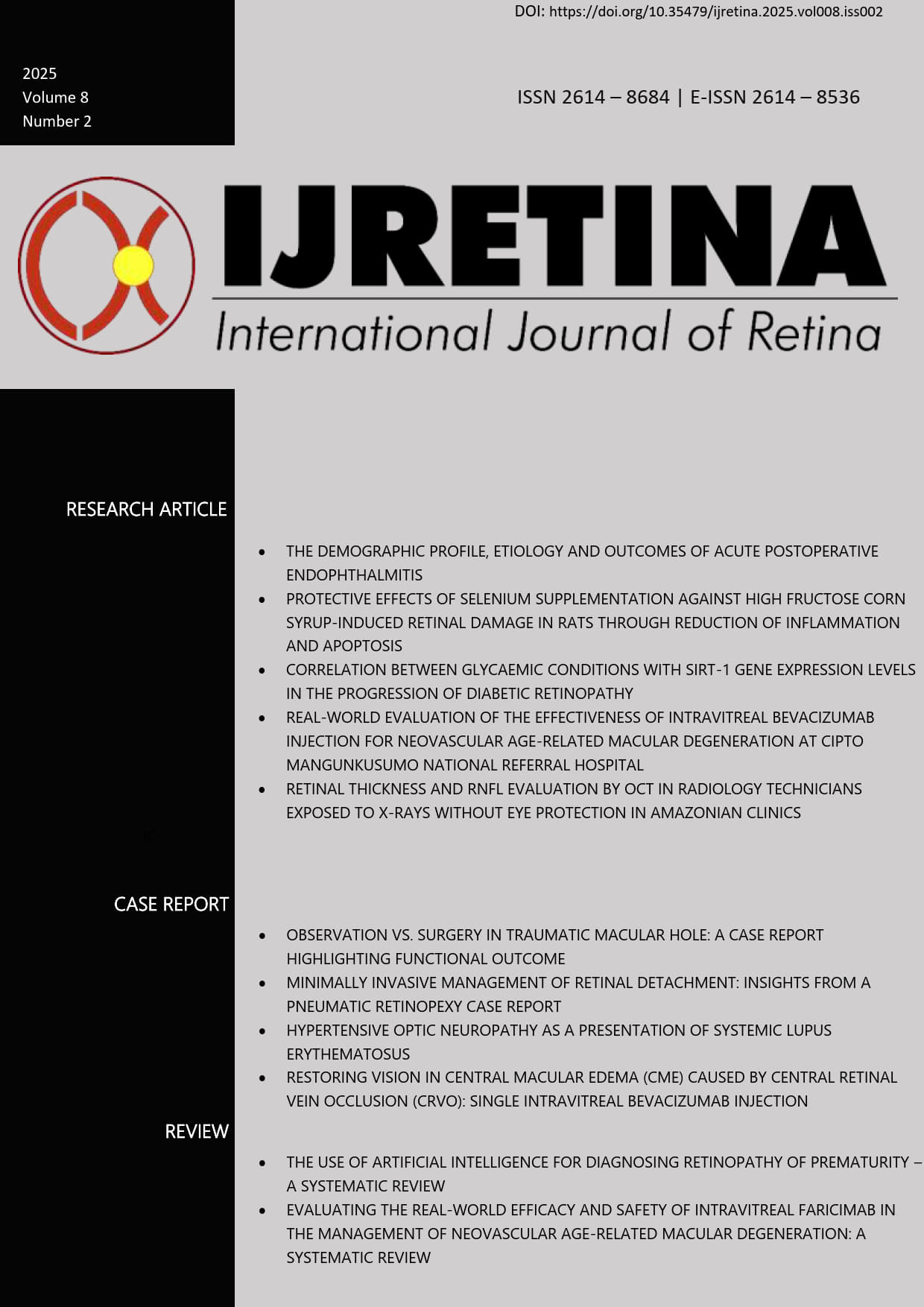The Demographic Profile, Etiology and Outcomes of Acute Postoperative Endophthalmitis
Main Article Content
Abstract
Introduction: To describe patient characteristics, bacterial patterns, management, and outcomes of therapy in patients with acute postoperative endophthalmitis.
Method: This observational, descriptive study was conducted at Dr. Saiful Anwar General Hospital in Malang, Indonesia, between 2020 and 2024, involving all patients with newly diagnosed acute postoperative endophthalmitis with periode follow up patient's initial visit, on day 7, and on day 28 following treatment
Results: A total of 74 patients were included in the study. The majority were male (51.3%), with a mean age of 61.57 ± 11.54 years. The most common comorbid was diabetes mellitus (16.2%). The etiology was most commonly due to gram-negative bacilli (13%), and phacoemulsification was the most common surgical procedure associated with endophthalmitis (74%). Quinolones exhibited the highest sensitivity. The most common management was a combination of medical and surgical treatments, including intravitreal antibiotic injections (59%) and combination of intravitreal antibiotic injections and pars plana vitrectomy (PPV) (18%) . The visual acuity outcomes revealed that 45,9% patients experienced improvement.
Conclusion: The incidence of endophthalmitis increases with advancing patient age, correlating with a higher frequency of cataract surgeries performed. Current management outcomes for endophthalmitis are favorable, reflecting improvements aligned with updated clinical guidelines. The comprehensive management of endophthalmitis will result in an improved visual outcome.
Article Details

This work is licensed under a Creative Commons Attribution-NonCommercial 4.0 International License.
References
2. Althiabi S, Aljbreen AJ, Alshutily A, Althwiny FA. Postoperative Endophthalmitis After Cataract Surgery: An Update. Cureus [Internet]. 2022 Feb 8; Available from: https://www.cureus.com/ articles/ 83185 - postoperative- endophthalmitis - after - cataract - surgery-an-update
3. Cunha AM, Iglésias MM, Rocha- Sousa A, Falcão-Reis F, Falcão. M. Endophthalmitis following Intravitreal Injection, Cataract Surgery, and Vitrectomy: Clinical Features and Visual Outcomes. J Ophthalmol. 2021;2021.
4. Jeong SH, Cho HJ, Kim HS, Han JI, Lee DW, Kim CG, et al. Acute endophthalmitis after cataract surgery: 164 consecutive cases treated at a referral center in South Korea. Eye (Basingstoke). 2017 Oct 1;31(10):1456– 62.
5. Siak J, Win MZA, Chee SP. Epidemiology and Treatment Trend of Endophthalmitis in Asia. In: Endophthalmitis. Springer Singapore; 2018. p. 29–44.
6. Kernt M, Kampik A, Kernt M. Clinical Ophthalmology Endophthalmitis: Pathogenesis, clinical presentation, management, and perspectives [Internet]. Clinical Ophthalmology. 2010. Available from: www.dovepress.com
7. Ting MYL, Pocobelli G, Butu DM, Mandal N, Nicholson L, Khan SR. Incidence and outcomes of post- operative endophthalmitis following elective phacoemulsification cataract surgery, between 2015 and 2022. Eye (Basingstoke). 2024 Dec 1;
8. Chen KY, Chan HC, Chan CM. Postoperative Endophthalmitis among Diabetic and Non- Diabetic Patients: A Systematic Review and Meta-analysis [Internet]. 2024. Available from: https://www.researchsquare.com
/article/rs-4740025/v1
9. Pathengay A, Khera M, Das T, Sharma S, Miller D, Flynn HW. Acute Postoperative Endophthalmitis Following Cataract Surgery. Asia-Pacific Journal of Ophthalmology. 2012;1(1):35–42.
10. Thoms SS, Musch DC, Soong HK. Postoperative endophthalmitis associated with sutured versus unsutured clear corneal cataract incisions. British Journal of Ophthalmology. 2007 Jun;91(6):728–30.
11. Yamamoto T. Bleb-related infection: Clinical features and management. Taiwan J Ophthalmol. 2012 Mar;2(1):2–5.
12. Lin J, Huang S, Liu M, Lin L, Gu J, Duan F. Endophthalmitis Caused by Pseudomonas aeruginosa: Clinical Characteristics, Outcomes, and Antibiotics Sensitivities. J Ophthalmol. 2022;2022.
13. Imamura T, Kakinoki M, Hira D, Kitagawa T, Ueshima S, Kakumoto M, et al. Pharmacokinetics of intravitreal vancomycin and ceftazidime in silicone oil-filled macaque eyes. Transl Vis Sci Technol. 2021;10(3):1–8.
14. Bari A, Chawla R, Mishra D, Das U, Hasan N, Satpathy G, et al. Real-life comparison of three intravitreal antibiotic drug regimens in endophthalmitis. Indian J Ophthalmol. 2022 May 1;70(5):1696–700.
15. Radhika M, Mithal K, Bawdekar A, Dave V, Jindal A, Relhan N, et al. Pharmacokinetics of intravitreal antibiotics in endophthalmitis. Vol. 4, Journal of Ophthalmic Inflammation and Infection. Springer Verlag; 2014. p. 1–9.
16. Wang T, Moinuddin O, Abuzaitoun R, Hwang M, Besirli C, Wubben TJ, et al. Retinal detachment after endophthalmitis: Risk factors and outcomes. Clinical Ophthalmology. 2021;15:1529–37.
17. Ying Z, Maria C, Spyridon D, Karl- Ulrich BS, Stephan SM, Christos S. Analysis of retinal detachment resulted from post-operative endophthalmitis treated with 23G pars Plana Vitrectomy. BMC Ophthalmol. 2021 Dec 1;21(1).
18. Senthamizh T, Aravind H, Singh TP. Factors associated with postoperative visual outcome in acute endophthalmitis after cataract surgery—a cross- sectional, analytical study. Digital Journal of Ophthalmology. 2022 Mar 31;28(1):1–6.
19. Suwal B, Khadka D, Shrestha A, Shrestha R. Treatment Strategies in Acute Post-operative Endophthalmitis after Cataract Surgery at a Tertiary Eye Hospital in Nepal: A 5-year Retrospective Review. Nepalese Journal of Ophthalmology. 2021 Jan
1;13(1):82–90.
20. Peng KL, Kung YH, Tsai HS, Wu TT. Treatment outcomes of acute poptoperative infectious endophthalmitis. BMC Ophthalmol. 2021 Dec 1;21(1).
21. Negretti GS, Chan W, Pavesio C, Muqit MMK. Vitrectomy for endophthalmitis: 5-year study of outcomes and complications. BMJ Open Ophthalmol. 2020 Mar 24;5(1).
22. Panahi P, Mirzakouchaki- Borujeni N, Pourdakan O, Arévalo JF. Early Vitrectomy for Endophthalmitis: Are EVS Guidelines Still Valid? Vol. 66, Ophthalmic Research. S. Karger AG; 2023. p. 1318–26.

